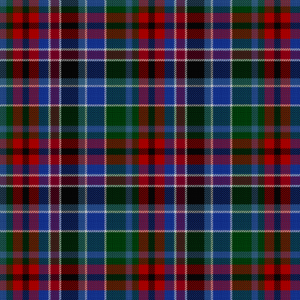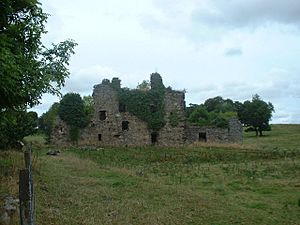Clan Gordon facts for kids
Quick facts for kids Clan Gordon |
|||
|---|---|---|---|
| Gòrdanach (Singular), Na Gòrdanaich (Collective) | |||
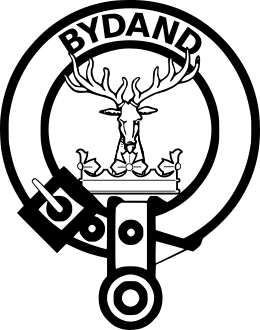
Crest: Issuant from a crest coronet Or a stag's head (affrontée) Proper attired with ten tines Or
|
|||
| Motto | Bydand (meaning "abiding" or "steadfast") Animo non Astutia (By Courage not by craft) |
||
| Slogan | An Gòrdonach | ||
| Profile | |||
| Region | Highland | ||
| District | Aberdeenshire | ||
| Plant badge | Rock ivy | ||
| Pipe music | "The Gordon's March", "Cock o' the North" | ||
| Chief | |||
 |
|||
| The Most Hon. Granville Charles Gordon | |||
| The 13th Marquess of Huntly (An Gòrdonach) | |||
| Seat | Aboyne Castle | ||
| Historic seat | Huntly Castle | ||
|
|||
|
|||
|
|||
|
|||
Clan Gordon is a very old and powerful Scottish clan from the Scottish Highlands. Their lands once covered a huge area. Today, the main home of the Clan Gordon is Aboyne Castle in Aberdeenshire. The leader of the clan is known as the Marquess of Huntly.
The Gordons played a big part in Scottish history. They supported William Wallace during the Wars of Scottish Independence in the 1200s. Later, in the 1400s, the clan's leadership passed to a woman. Her family then took the Gordon name. The Gordons also helped defeat a rebellion by the Earl of Douglas in the 1400s. In the 1500s, the Gordons had conflicts with the Clan Forbes. They also fought against the Earl of Argyll at the Battle of Glenlivet. During the 1600s, the Gordons supported the King in the Wars of the Three Kingdoms. In the 1700s, some Gordons supported the Jacobite cause. Later, during the Jacobite rising of 1745, the clan's chief supported the government. However, many clan members still chose to support the Jacobites.
Contents
History of Clan Gordon
Early Beginnings of the Clan
The first Gordon mentioned in history was Richard of Gordon. He was said to be the grandson of a brave knight. This knight famously defeated a large animal in a place called the Merse. Richard was the Lord of the Barony of Gordon. He likely died around the year 1200.
Between 1150 and 1160, Richard gave some land to monks. His son, Thomas Gordon, later confirmed this gift. Another famous Gordon from this time was Bertram de Gordon. He wounded King Richard of England with an arrow.
Alicia Gordon, a female leader of the family, married her cousin, Adam Gordon. Adam was a soldier. King Alexander III of Scotland sent him to Palestine with King Louis of France. It is believed that most Gordons in Scotland today come from Adam's grandson, Sir Adam. This Sir Adam Gordon helped Sir William Wallace in 1297. They worked to take back Wigtown Castle from the English. Adam was then made the Governor of the castle.
Fighting for Scottish Freedom
During the Wars of Scottish Independence, Sir Adam Gordon first supported Edward I of England. But he soon changed his mind. He became a strong supporter of Robert the Bruce, the Scottish King. Adam was killed leading the Clan Gordon at the Battle of Halidon Hill in 1333. However, his son, Sir Alexander Gordon, escaped. He was the first Gordon to be called "of Huntly."
The clan chief, Sir John Gordon, was killed leading the clan. This happened at the Battle of Otterburn in 1388. The English were defeated in that battle. His son, Chief Sir Adam Gordon, was also killed leading the clan. This was at the Battle of Homildon Hill in 1402. This chief had only one child, a daughter named Elizabeth Gordon. She married Alexander Seton, the son of the chief of Clan Seton.
Clan Conflicts in the 1400s
The Battle of Arbroath took place in 1445. Patrick Gordon of Methlic, a cousin of the Earl of Huntly, was killed fighting the Clan Lindsay. The Earls of Aberdeen are descended from this Patrick Gordon.
In 1449, Alexander Seton, 1st Earl of Huntly, made a big change. He was the eldest son of Elizabeth Gordon. He changed the family name from Seton to Gordon around 1457. His male children, through his third wife, Elizabeth Crichton, kept the Gordon name. They continued to be the chiefs of Clan Gordon.
The chief of Clan Lindsay, Alexander Lindsay, was badly beaten. This happened at the Battle of Brechin in 1452. The Clan Gordon and Clan Ogilvy defeated him. They were led by Alexander Gordon, 1st Earl of Huntly.
The Gordons then got involved in a big conflict. It was between the king and the powerful Clan Douglas. The Gordons supported the king. When the Gordons moved their army south, the Earl of Moray attacked. He was an ally of the Douglases. He destroyed Gordon lands and burned Huntly Castle. But the Gordons returned and quickly defeated their enemies. Huntly Castle was rebuilt. When the Douglases were finally defeated, the Gordons became very powerful. In 1454, the Douglases rebelled again. They were defeated by the king in the south and Huntly in the north. This ended the alliance of the Douglases, Rosses, and Crawfords. For his help, Alexander Gordon, 1st Earl of Huntly, was called Cock o' the North. This title has been used for the Gordon chiefs ever since.
Clan Conflicts in the 1500s
In 1513, during the Anglo-Scottish Wars, the Clan Gordon fought. They were led by Alexander Gordon, 3rd Earl of Huntly, at the Battle of Flodden.
In 1515, the title of Earl of Sutherland went to Adam Gordon. He was a younger son of George Gordon, 2nd Earl of Huntly. This happened through marriage.
Later, in the Anglo-Scottish Wars, George Gordon, 4th Earl of Huntly defeated an English army. This was at the Battle of Haddon Rig in 1542. However, the Gordons were part of the Scottish army that lost at the Battle of Pinkie Cleugh in 1547.
Chief George Gordon, 4th Earl of Huntly, was a military leader. He fought against the forces of Henry VIII of England. He won many battles. However, he was later killed at the Battle of Corrichie in 1562. He was fighting against the forces of James Stuart. Gordon was killed, and his son, Sir John, was later executed.
Throughout the 1500s, the Clan Gordon had a long conflict with the Clan Forbes. In the 1520s, people from both sides were killed. Seton of Meldrum, a close relative of the Gordon chief, was killed by the Forbeses. The Earl of Huntly then accused the Master of Forbes of trying to kill James V of Scotland. The Master of Forbes was found guilty and executed. However, his conviction was later overturned.
The Protestant Reformation made the feud worse. The Gordons remained Catholic, while the Forbeses became Protestant. Other clans joined sides. The Clan Leslie, Clan Irvine, and Clan Seton sided with the Gordons. Protestant families like the Clan Keith, Clan Fraser, and Clan Crichton sided with the Forbeses. In 1571, twenty Gordons were killed at a dinner at the Forbes's Druminnor Castle. Later that year, the feud reached its peak. Battles took place at Tillieangus and Craibstone. Druminnor Castle was also looted. The Gordons then killed twenty-seven Forbeses at Corgarff Castle. It took two special laws from Parliament to make the clans stop fighting.
For two hundred years, from the mid-1400s, the Clan Gordon and Clan Campbell were very powerful. They controlled the northeast and west of Scotland. In 1594, Archibald Campbell, 7th Earl of Argyll was given permission to act against George Gordon, 6th Earl of Huntly. But Argyll was defeated at the Battle of Glenlivet.
The 1600s and Civil War
In 1615, there was a complaint from Alexander Leask of the Clan Leask. He said that Adam Gordon, attacked him and wounded him. Later that year, the Gordons attacked the Leasks again. George Gordon was declared an outlaw for this. In 1616, William Leask was attacked by John Gordon and his men.
In the early 1600s, Clan Gordon had many alliances. They had a strong friendship with the Clan Burnett of Leys. The Gordon family symbol is on the ceiling of Muchalls Castle. This castle was built by Alexander Burnett.
In 1644, Alexander Bannerman fought a duel with his cousin, Sir George Gordon. Sir George was wounded. Also in 1644, during the Civil War, Gordons fought on both sides. Lord Lewis Gordon led his forces for the Covenanters. Sir Nathaniel Gordon led his forces for the Royalists.
During the Civil War, the second Marquess of Huntly was a strong supporter of the King. His followers were known as the Gordon Horse. They played a big role in the battles of James Graham, 1st Marquess of Montrose. Gordon cavalry fought for the Royalists at the Battle of Auldearn in 1645. They helped defeat the Covenanters. The Clan Gordon also fought at the Battle of Alford in 1645. They won this battle, led by George Gordon, 2nd Marquess of Huntly. The Marquess of Huntly's oldest son, George Gordon, died in this battle. Also in 1645, Lewis Gordon, the clan chief, burned Brodie Castle.
In 1682, William Gordon of Cardoness Castle was killed in a fight. His killer, Sir Godfrey McCulloch, fled Scotland. He returned later and was executed in 1697.
The 1700s and Jacobite Rebellions
The 1715 Jacobite Uprising
The Gordons fought on both sides during the Jacobite rising of 1715 and the Jacobite rising of 1745. The second Duke of Gordon joined the Jacobites in 1715. He fought at the Battle of Sheriffmuir. A report from 1724 estimated the clan had about 1,000 fighting men.
The 1745 Jacobite Uprising
Cosmo Gordon, 3rd Duke of Gordon supported the British Government in 1745. However, his brother, Lord Lewis Gordon, raised two Jacobite regiments. These regiments fought against the government forces. The Gordon Jacobites fought at the Battle of Inverurie (1745). They also fought at the Battle of Falkirk (1746) and the Battle of Culloden (1746).
British Army Regiments
Two army regiments were named "Gordon Highlanders." The first was the 81st Regiment of Foot (Aberdeenshire Highland Regiment). It was formed in 1777 by Colonel William Gordon. This regiment was disbanded in 1783. The second was the 92nd (Gordon Highlanders) Regiment of Foot. It was formed by Alexander, the 4th Duke of Gordon, in 1794.
Clan Chief and Symbols
- The Chief of Clan Gordon is Granville Charles Gomer Gordon. He is the 13th Marquess of Huntly. He also holds other titles like Earl of Enzie and Lord Gordon of Badenoch.
- The Chief of Clan Gordon is famously known as: The Cock o' the North.
- The Chief's Arms show different symbols. The first part has three boar's heads for Gordon. The second part has three lion's heads for the Lordship of Badenoch. The third part has three crescents for Seton. The fourth part has three fraises (strawberry flowers) for Clan Fraser.
Gordon Tartans
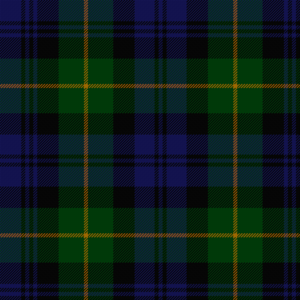
Clan Gordon has several official tartans. Most of them are mainly green, blue, and black. But there are also dress patterns, some red ones, and special versions for different parts of the clan.
The main Gordon tartan comes from the one used by the 92nd (Gordon Highlanders) Regiment of Foot. The clan's version has thinner black lines. It also has thin black "guard lines" next to the yellow lines. This tartan is based on the Black Watch tartan. The 92nd Regiment later became the Gordon Highlanders in 1881.
This main Gordon tartan has been used for many years by the 10th Finchley (Scottish) Scout Group in London. This Scout Group is special because it is the only one south of Scotland that wears kilts. They keep strong ties with the Gordon clan. Every few years, they camp at Aboyne Castle. The Marquess of Huntly often attends their Burns Night dinners. The group's pipe band always plays "The Cock of the North 6/8 March." Every member wears a badge with the stag's head, which is part of the clan crest. The scout hall is even called Gordon Hall.
Gordon Castles
The Clan Gordon has owned many castles over time. Here are some of them:

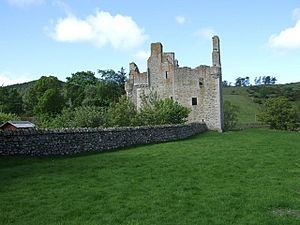
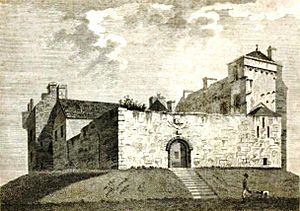
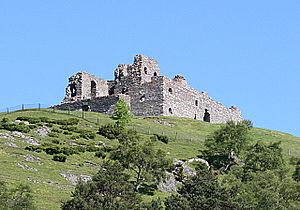
- Gordon Castle was an old fort near the village of Gordon, Scottish Borders. The Gordons owned it from the 1100s. Because they supported Robert the Bruce, they were given lands in Strathbogie in Aberdeenshire. A mile from Strathbogie was Huntly. The Gordons also had a castle there. This castle, originally called Strathbogie, later became known as Huntly Castle.
- Huntly Castle is a ruin north of Huntly in Aberdeenshire. It is a large stone building with a round tower. The lands passed to the Gordons in the 1300s. The original castle was burned by the Clan Douglas in 1452 and then rebuilt. Its name changed to Huntly in 1506. During the Jacobite rising of 1745, soldiers used the castle.
- Abergeldie Castle is west of Ballater, Aberdeenshire. It dates from the 1500s. The Gordons owned Abergeldie from 1482. In 1547, James Gordon of Abergeldie died at the Battle of Pinkie Cleugh. In 1562, Alexander Gordon of Abergeldie joined a rebellion against Mary, Queen of Scots. He was also at the Battle of Glenlivet in 1594. The castle was burned by the Clan Mackenzie in 1592.
- Glenbuchat Castle is west of Kildrummy, Aberdeenshire. It was built in 1590. James VI of Scotland took it during a rebellion in 1594. Brigadier-General John Gordon of Glenbuchat fought for the Jacobites in 1715 and 1745. He led the Gordons at the Battle of Culloden. He escaped to Norway and died in France. The castle was a ruin by 1738. It is now looked after by Historic Scotland.
- Rothiemay Castle was near Milltown of Rothiemay. It was built in the 1400s. Mary, Queen of Scots might have stayed there in 1562. In 1618, George Gordon of Gight attacked the castle. In 1630, William Gordon of Rothiemay died in a fire at Frendraught Castle. Lady Rothiemay later hired Highlanders to attack Frendraught.
- Haddo House is north-west of Ellon, Aberdeenshire. It stands where a Gordon stronghold was since 1429. Patrick Gordon of Haddo died at the Battle of Arbroath in 1446. Sir John Gordon of Haddo supported James Graham, 1st Marquess of Montrose during the Civil War. He was captured after his castle was surrounded. Haddo House is now cared for by the National Trust for Scotland.
- Fyvie Castle is north of Fyvie, Aberdeenshire. The Gordon Earls of Aberdeen owned it from 1733 to 1889.
- Kenmure Castle is south of New Galloway. The Gordons of Lochinvar got it around 1297. It was burned after the Gordons welcomed Mary, Queen of Scots in 1568. In 1633, Sir John Gordon became Viscount of Kenmure. The castle was burned again by Oliver Cromwell in 1650. William Gordon, the sixth Viscount Kenmure, was captured fighting for the Jacobites. He was later executed. The castle was restored but was damaged by fire in 1950.
- Auchindoun Castle near Dufftown is a ruined tower house. It passed to the Gordons in 1535. Adam Gordon of Auchindoun led a group of Gordons who burned Corgarff Castle. Many people died there. Auchindoun Castle itself might have been burned in 1544 or 1671. It was damaged after the murder of James Stewart, 2nd Earl of Moray in 1592. Sir Patrick Gordon of Auchindoun was later killed at the Battle of Glenlivet in 1594. The castle is now cared for by Historic Scotland.
- Gight Castle is near Fyvie, Aberdeenshire. William Gordon of Gight died at the Battle of Flodden in 1513. The seventh Gordon laird of Gight was a tax collector who kept all the money from Banff, Aberdeenshire. The heiress, Catherine Gordon of Gight, married John "Mad Jack" Byron. They were the parents of the famous poet Lord Byron. John Byron had to sell the estate because of debts. It was bought by the Gordon Earls of Aberdeen.
- Aboyne Castle is near Aboyne, Aberdeenshire. It is the current home of the Marquess of Huntly, who is the chief of Clan Gordon.
More About the Gordons
- Marquess of Huntly
- Marquess of Aberdeen and Temair
- Duke of Gordon
- Lord Byron (George Gordon Byron, 6th Baron Byron)
- Gordon Highlanders


